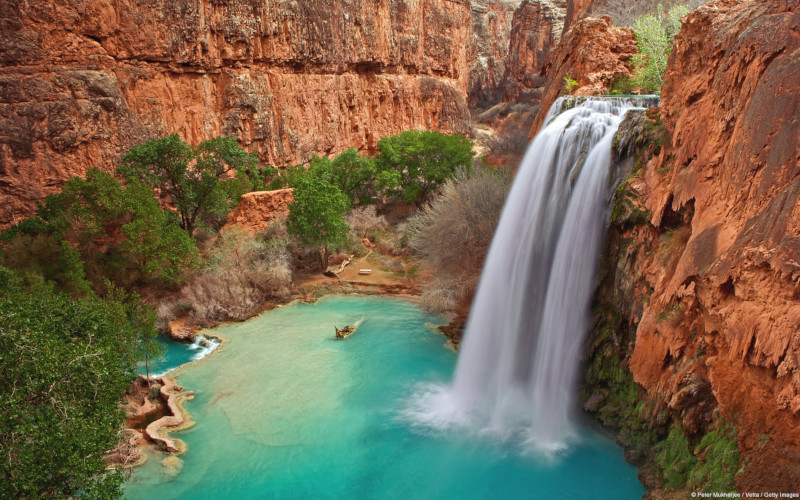
Havasu Falls Facts
- Without doubt, the mesmerizing Havasu Falls easily ranks as one of the most beautiful waterfalls in the world. It also goes by the name of Havasupai Falls. By either name, the site also remains one of the most difficult falls in the world to access.
- That lamentable fact, however, serves to provide it with at least a measure of protection, to preserve it in its natural state. In point of fact, two very specific factors currently serve to limit access to this marvel of Nature, aiding its preservation.
- The site sits on tribal land belonging to a small group of Indigenous Peoples. Understandably, the tribe strictly regulates the number of visitors to the location. Access to the site remains limited to those acquiring a permit from local authorities.
- In addition to this requirement of man, the very nature of the surrounding terrain also serves to make it difficult to access. Although this makes it more difficult for those who appreciate Nature to view it, this fact can certainly be respected.
- The local topography makes it nearly impossible to gain access to the site from the ground without the knowledge of the indigenous inhabitants of the region. Its sheer natural beauty gives this awesome wonder of Nature a truly powerful allure.
- This trait has garnered breathtaking Havasu Falls international attention several times, in some ways. With the permission and cooperation of local authorities, its beauty has been featured in both a Hollywood movie, and a music video.
Related Articles
Havasu Falls Physical Description
The fame of the truly stunning Havasu Falls derives purely from its natural beauty. This notoriety, although certainly well-deserved, has no basis in its physical size. This holds true due to the fact that the waterfall represents no more than an average sized cascade.
This status pertains to both its height and width. For one thing in particular, the waterfall itself consists of a single stage, much like the vast majority of similar features scattered throughout the world. In its case, the water plunges a total of about 100 ft (30 m).
It also does so over a series of several vertical cliffs. These cliffs have a composition primarily consisting of dark reddish sandstone. Without a doubt, the most visually striking feature of Havasu Falls remains the breathtaking color of the water itself.
This occurs due entirely to the fact that the underlying rock strata contains high concentrations of calcium carbonate. This natural compound slowly but steadily distills into the flow of water, continually providing that water with an astounding aquamarine color.
Havasu Falls Location, Formation, and History
Surprisingly, Havasu Falls sits within another larger, and far better known, natural marvel. That other wonder of Nature is none other than the Grand Canyon itself. The waterfall, therefore, formed in what now constitutes the state of Arizona, in the United States.
Along with the canyon, this waterfall forms another of the great natural wonders of North America. The stunning cascade formed on what became tribal land of the Native American tribe, the Havasupai. The tribe has lived at the site for more than 800 years.
This astonishingly beautiful cascade also formed through a unique, but highly effective, combination of two processes. These factors in its creation consisted of both slow erosion over time, and rapid erosion due to the occurrence of flash floods in the area.
The high levels of calcium carbonate in the water also leaves deposits as it flows along. Over time, these minerals built up in several places, forming small but magnificent travertine steps. The frequent flash floods in the region often changes these, however.
Sometimes one or more of these beautiful but very delicate features becomes reduced due to the force of the flood, or even demolished, to be reformed later. Because of the occurrence of the same flash floods, the nature of the waterfall itself often changes.
Prior to one powerful flood, Havasu Falls flowed in one broad sheet. Since then, the form of the flow has changed on several occasions. Currently, it flows in a single sheet of water, whose temperature remains a near-constant 70 degrees Fahrenheit (20 Celsius).
Features Sharing Its Region
Check out our other articles on 7 Outstanding Flightless Birds of the World, African Manatee, Onyx River, Bleeding Tooth Fungus, Purple Frog, Sea Marigold, Red Veined Darter, Green Iguana
